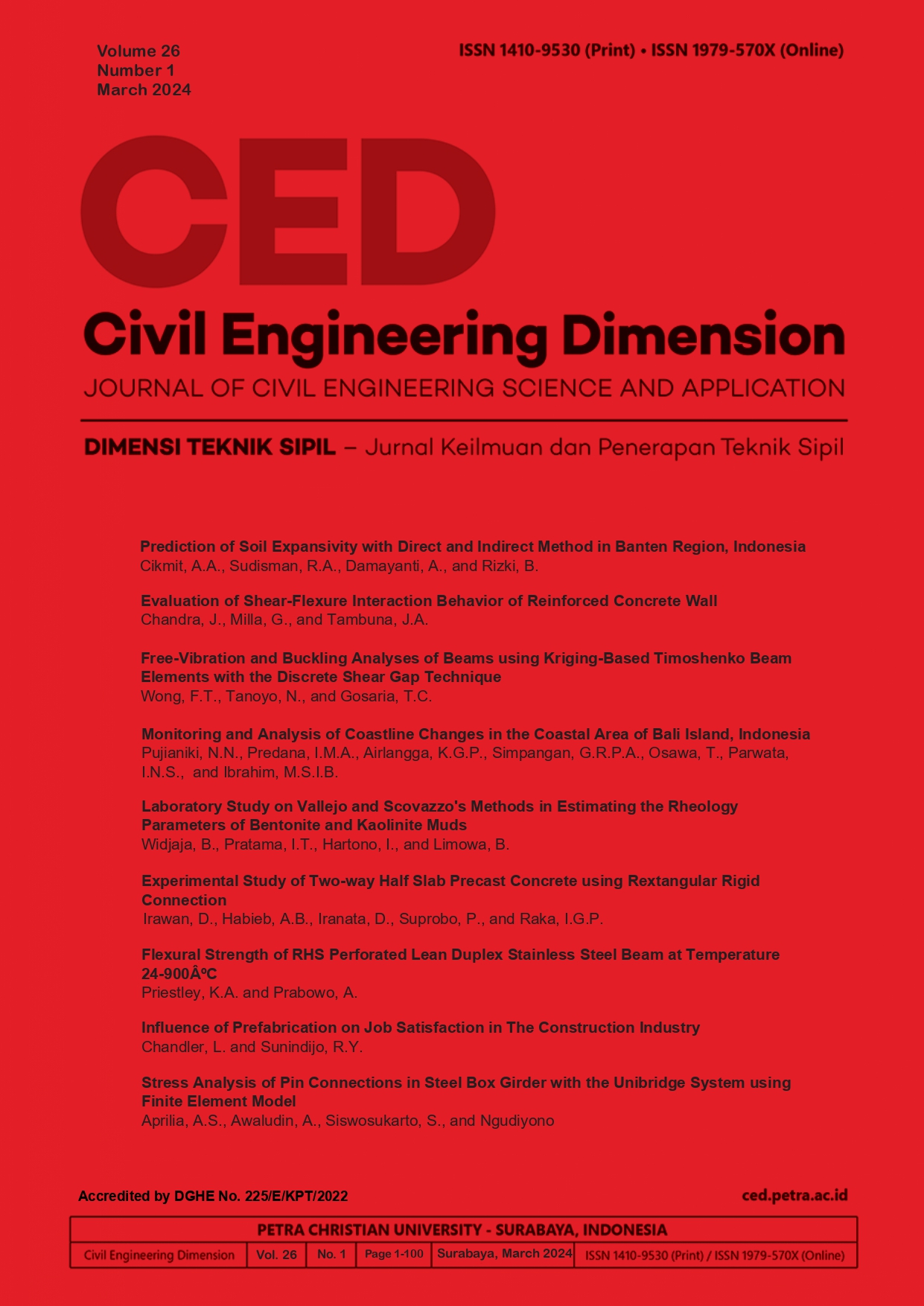Evaluation of Shear-Flexure Interaction Behavior of Reinforced Concrete Wall
DOI:
https://doi.org/10.9744/ced.26.1.11-20Keywords:
reinforced concrete (RC) wall, moderate height to length ratio, shear-flexure interaction (SFI), cyclic loadingAbstract
Reinforced concrete (RC) wall is a critical structural member that resists lateral loadings, such as earthquake and wind. RC wall having moderate height to length ratio, 1.50-2.50, has the altered shear-flexure interaction (SFI) behavior, so shear and flexural failure mechanisms occur almost concurrently. Therefore, an experimental study of a moderate RC wall was conducted as a comprehensive study of the wall’s coupled nonlinear shear-flexure behavior under cyclic loading. The experimental results show that the RC wall failed in flexure mechanism, indicated by crushing of the flexural compression zone, and followed by immediate shear failure, notified by the occurrence of web crushing. In addition to the experiment, an analytical model using SFI-MVLEM element in OpenSees software was performed to verify the experimental results. The analytical results show that the model is able to simulate reasonably well the coupled nonlinear shear-flexure behavior of the RC wall subjected to cyclic loading.
References
Kolozvari, K.I., Analytical Modeling of Cyclic Shear-Flexure Interaction in Reinforced Concrete Structural Walls, (Ph.D. Dissertation), University of California, Los Angeles, 2013.
Orakcal, K., Wallace, J.W., and Conte, J.P., Flexural Modeling of Reinforced Concrete Walls Model Attributes, ACI Structural Journal, 101(5), 2004, pp. 688–698.
Purnomo, J. and Chandra, J., Evaluation of a Reinforced Concrete Wall Macroscopic Model for Coupled Nonlinear Shear-Flexure Interaction Response, Civil Engineering Dimension, 20(1), 2018, pp. 41-50.
Chang, G.A. and Mander, J.B., Seismic Energy Based Fatigue Damage Analysis of Bridge Columns: Part I-Evaluation of Seismic Capacity, State University of New York, Buffalo, NY, NCEER-94-0006, 1994, pp. 222.
Menegotto, M. and Pinto, E., Method of Analysis for Cyclically Loaded Reinforced Concrete Plane Frames Including Changes in Geometry and Non-Elastic Behavior of Elements under Combined Normal Force and Bending, Proceeding of IABSE Symposium on Resistance and Ultimate Deformability of Structures Acted on by Well Defined Repeated Loads, 1973, pp. 15–22.
Filippou, F.C., Popov, E.P., and Bertero, V.V., Effects of Bond Deterioration on Hysteretic Behavior of Reinforced Concrete Joints, Earthquake Engineering Research Center, University of California, Berkeley, CA, UCB/EERC-83/19, 1983.
ACI Committee 318, Building Code Requirements for Structural Concrete (ACI 318-14) and Commentary (ACI 318R-14), American Concrete Institute, Farmington Hills, MI, 2014, 519 pp.
ASCE 41-17, Seismic Evaluation and Upgrade of Existing Buildings, American Society of Civil Engineers, Reston, Virginia, 2017.
Teng, S. and Chandra, J., Cyclic Shear Behavior of High Strength Concrete Structural Walls, ACI Structural Journal, 113(6), 2016, pp. 1335-1345.
Chandra, J., Liu, Y., and Teng, S., Analytical Study on High Strength Concrete Shear Walls, 36th Conference on Our World in Concrete and Structures, Singapore, 2011, pp. 221-230.
ACI Committee 318, Building Code Requirements for Structural Concrete (ACI 318-19) and Commentary (ACI 318R-19), American Concrete Institute, Farmington Hills, MI, 2019, 623.
Downloads
Published
How to Cite
Issue
Section
License
Copyright (c) 2024 Jimmy Chandra

This work is licensed under a Creative Commons Attribution 4.0 International License.
Authors who publish with this journal agree to the following terms:- Authors retain the copyright and publishing right, and grant the journal right of first publication with the work simultaneously licensed under a Creative Commons Attribution License that allows others to share the work with an acknowledgement of the work's authorship and initial publication in this journal.
- Authors are able to enter into separate, additional contractual arrangements for the non-exclusive distribution of the journal's published version of the work (e.g., post it to an institutional repository or publish it in a book), with an acknowledgement of its initial publication in this journal.
- Authors are permitted and encouraged to post their work online (e.g., in institutional repositories or on their website) followingthe publication of the article, as it can lead to productive exchanges, as well as earlier and greater citation of published work (See The Effect of Open Access).











